RARE 81 TURBO TRANS AM NASCAR DAYTONA 500 PACE CAR 30K MILES ALL ORIGINAL
- Price: Ask a price!
- Condition: Used
- Item location: Saint Louis, Missouri, United States
- Make: Pontiac
- Model: Trans Am
- SubModel: TURBO TRANS AM
- Type: SPORTSCAR
- Trim: TRANS AM TURBO NASCAR DAYTONA 500 PACE CAR SE
- Year: 19810000
- Mileage: 30301
- VIN: 1G2AX87T1BL122094
- Color: White
- Engine size: 4.9L 301 CID
- Number of cylinders: 8
- Power options: Air Conditioning, Cruise Control, Power Locks, Power Windows
- Fuel: Gasoline
- Transmission: Automatic
- Drive type: 4 WHEEL DISC BRAKES
- Interior color: RED/BLACK RECARO
- Safety options: Anti-Lock Brakes
- Options: Cassette Player
- Vehicle Title: Clear
Pontiac Trans Am 19810000 Description
1981 Pontiac NASCAR Turbo Trans Am Recaro Special Edition Pace Car SurvivorShow or Drive
5 time car show trophy winning car
T-TopCar
This unrestored carhasonly 30301 all originalmiles.I purchased the car 15 years ago with 26,000 miles on it.
Always garaged car that runs and drives great and idles as smooth as it was new.
I have replaced the tires with original BFG Radial TA's 225/70r15 white letter and replaced all hoses and ignition wires& have had a/c converted over tor134All other components are original.
It has just 30301Mileson it and everything works.
I have the title in hand ready to sadlysign over to its new proud owner
This car is the Recaro T/A Nascar Daytona 500 Pace Car.
The Recaro is one of the most sought after cars around
and to have a completely originial low mile car is incredible.
This 1981 NASCAR Turbo Trans Am Special Edition Pace Car
is one of only 2,000 manufactured during the 1981 model year.
This car has the "X87" Code in the VIN number.
The car is completely loaded with all available options including
the 301 Turbo Charged Engine, utomatic Transmission,
Limited Slip Rear End,
4 Wheel Power Disc Brakes,
Power Steering, S-6 Performance Suspension,
Factory Air Conditioning, actory T-Tops,
Power Windows, ower Door Locks,
Tach & Gauges,
Tilt Steering, ruise Control,
Pace Car Unique AM-FM-Cassette red colored Stereo Radio,
Turbo Hood Lights, ower Antennae,
Turbo Style Aluminum Wheels,
Delayed Windshield Wipers,
Sport Mirrors,
UNIQUE Recaro Black/Red Seat Interior, br> Rear Window Defogger, ower Trunk Release,
Bucket Seats, onsole,
Sport Trans Am Steering Wheel and More!
The Turbo Special Eition Y85 package includes red carpeting,
embroidered bird on door panels and rear seat,
red instrument lighting, igital display (ETR) radio.
The exterior has two-tone paint, hite lower and black roof T-top section
with specific stripes.
Specific NASCAR decals on front and rear fenders & official Daytona 500 Pace car decal on doors,
Recaro T/A door handle inserts and
hood mounted 3-stage turbo boost indicator panel.
Pontiac 4.9-Liter Turbo Charged V8 engine,
original BFG Radial TA's 225/70r15 white letter tires,
15X9 inch turbo cast aluminum white center wheels and limited slip rear axle.
I purchased this car from the second owner in 2002.
He told me the car has always been aGeorgia car as far as he knew and currently in Missouri but never driven in the Rain or snow.
The car has beenGaraged all of its life.
The cars starts up easily and runs great.
The transmission shifts properly and the brakes stop the car properly but could use the rotors roughed up a bit as they have never been turned or replaced.
The wheels centers are in excellent condition with nice center caps and original eagle emblems.
The wheels lug nuts are also the correct and the original rust free lug nuts.
Under the hood the car is completely original with all original components in place.
The car still retains the original catalytic converter and original exhaust.
Everything around the engine is complete including all the original air conditioning,
radiator, an shroud, aster cylinder, orns, xhaust manifolds,
air cleaner, ruise control etc.
The original spare tire, ack and equipment are still mounted in the truck as original.
The exterior of the car is inawesome originalcondition with great lustre.
The body on this car is EXCELLENT!
There is norust and only the one small ding on the passenger fender unfortunately right on the body line but is hardly noticeable.
The floors, uarter panels, oors, enders, oof, runk pan, runk drop-offs
and more are all EXCELLENT condition.
All the glass in the car is in good condition and
that includes the windshield although it does have a few dings from the previous owner trailoring the car.
The interior of the car is completely original and flawless including original optional front & rear floor mats
this includes the original dash pad that has NO cracks at all!
The original gauges are complete and in nice condition.
The original steering wheel is inexcellent condition along with the horn button.
The original and unique to this Pace Car red digital AM-FM-Cassette Radio is correct and works perfectly with original speakers.
The original & unique red carpet is complete and spotless.
The original and unique RECARO seats are inexcellent condition
with the original net headrests with bits of the original plastic covers still around the metal posts of the headrests.
The original & unique embroidered door panels are inexcellent condition.
The original armrests are in excellent condition.
The headliner is also excellent.
The seat belts are all complete and inexcellent condition and rear appear to have been unused at all.
Overall this isone of if not the best
1981 NASCAR Turbo Trans Am Pace Car out there.
The car is very complete with virtually all the unique originalparts
to this car present and inexcellent condition.
Includes original window sticker and copy laminatedalong withbuild sheets still in original places and along with all of the records from previous owner and any original parts replaced included also.
Included are the 5 time winning trophies/plaques from the local car shows.& although not an original the yellow pace car light with magnetic mount and cigarette lighter plug and switch (no lights were actually offered but were used in the race).
Also includes custom fitted car cover in red/black color and original carpet type floor mats (along withoriginal rubber type).
This is the exact same model of car as owned by the current vice president Joe Biden and he enjoys his daily driver.
More facts about this Rare car:
There are those who believe that Trans Am production ceased when the 2002 model year came to a close. Technically they would be correct, ut from a purist point of view they would be wrong. The last Trans Am truly in tune with the original Trans Am spirit ceased production in 1981. The Trans Ams that came after 1981 were worthy performance cars and many of them are downright fun to drive, owever a Pontiac V8 was no longer part of the equation from 1982 until 2002. Pontiac at the end of the 1981 model year was forced by GM's new for 1982 corporate engine policy to retire its last production Pontiac V8 - the 4.9 liter (301 CID). Thereafter the Trans Am had to make due with the same Chevrolet derived small-block V8s that were found in performance Camaro models from 1982 to 2002. Pontiac could have picked other engines from GM's corporate engine list such as the Oldsmobile 5.0 liter (307 CID) V8 or Buick's 3.8 liter V6 starting in 1982, ut it wisely chose the small-block Chevy V8 due to its large array of aftermarket performance parts.
There were suspension tuning differences between the Trans Am and the performance Camaro models from 1982 to 2002, ut when it came to its soul, he Trans Am had become a pseudo Camaro with a Trans Am exterior and interior. Only time when the Trans Am after 1981 deviated from this course was with the (1989) 20th Anniversary Edition Trans Am which was equipped with the powerful Buick SFI Turbo 3.8 liter V6. Most Trans Am fans during this era adapted and accepted these cars with open arms - they were just happy a rear-wheel drive performance oriented V8 powered Pontiac Trans Am was still around even if a Chevrolet small-block was nestled under the hood.
To understand the purist point of view you have to go back to the heyday of GM in the 1950s and 1960s when each GM division had its own unique engines to go with its unique exterior and interior styling. Very rarely were engines shared among cars from different GM divisions. In other words when you bought a Buick you got a Buick motor under the hood painted in a Buick engine color like red. When you bought a Pontiac, t had a Pontiac motor painted in one of the different Pontiac engine blue hues. And with a Chevrolet there was a bright orange painted motor under the hood. All these differences fueled rivalry between these different GM divisions as if they were different auto companies and not divisions. As an example, f someone said back in the day he or she was a Chevrolet person they didn't even think to venture onto a Pontiac dealership lot - that was enemy territory.
By the 1970s things were changing, ngine sharing among the different GM divisions was becoming more commonplace, owever the different divisions still produced their own V8 engines. By the late-1970s GM mandated that its divisions paint their motors in GM corporate blue which remained the official GM engine color until black (starting in 1983) became the new official color for all GM engines.
When most of the other muscle cars in the 1970s either disappeared or dropped their engine displacement. Pontiac had no part in that sellout, or its high performance Trans Am motors during the 1970s it provided Pontiac 400 or 455 CID V8s - even the Corvette and Camaro Z28 had dropped to 350 CID by the mid-1970s and the Mustang was down to 302 CID. Not Pontiac, t started off the decade with the high-performance 345 gross horsepower Ram Air IV 400 CID V8 as the 1970 Trans Am's top engine and ended the decade with the high-performance 220 horsepower (rating was underrated) W72 400 V8. The W72 which had high performance heads along with some other performance goodies was rated by NHRA at 260 net horsepower. Hot Rod magazine tested a 1979 Trans Am equipped with the W72 400 and obtained a 1/4 mile in 14.6 seconds @ 96.6 mph - very impressive considering the 1979 W72 Trans Am weighed in at almost 4,000 lbs. Unfortunately GM cancelled the Pontiac 400, nd all that was left for the 1980 model year was the Pontiac 4.9 liter (301 CID) V8. The 4.9 liter was an engine that had been released for the 1977 model year as a economy V8 and was soon unexpectedly was elevated to top dog performance engine for Pontiac. Filling the shoes of the W72 400 and the other large displacement V8s before it, as an amazingly tall order - similar to a star quarterback being replaced in a Super Bowl game with a third string quarterback with no NFL experience. Pontiac engineers who even in the roughest of times in the 1970s always managed to keep the Trans Am at the top of the performance heap, eleased a turbo 4.9 liter V8 as the 1980 Trans Am's top performance motor. It was a bold move and it worked, t was rated at 210 net horsepower and 345 lb-ft of torque which was more horsepower and torque than the 1980 Camaro Z28 and 1980 Ford Mustang. For 1981 the magic continued however an onboard computer was added and horsepower dropped to 200, nd torque to 340 lb-ft. Though the turbo 4.9 was considerably slower than the W72 400, t managed to keep Trans Am buyers happy and remain ahead of most of the competition. Not to mention the (LU8) turbo 4.9 liter V8 was a Pontiac developed and engineered V8 giving the Trans Ams equipped with this motor and the base 150 horsepower 4-bbl 4.9 liter V8 the distinction of being all Pontiac. However as a foreshadow of the near future the 145 horsepower Chevrolet LG4 4-bbl 5.0 liter (small-block) V8 was also a Trans Am engine option for 1981 - the next year the LG4 would become the all-new third generation Trans Am's standard motor. For 1981 the 5.0 liter was the only Trans Am engine that could be equipped with a manual transmission - a 4-speed. The 5.0 liter for 1981 could not ordered with an automatic transmission.
1981 may have been the last year of the successful second generation (1970-1981) Trans Am, ut Pontiac ended this run with a bang - it released a limited production NASCAR (Daytona Pace Car) edition. The NASCAR edition just like the 1979 10th Anniversary and 1980 Indy Pace Car edition Trans Ams, ad a two tone paint scheme with lots of wild decals and pinstripes. The NASCAR edition had a white exterior color with black paint accents, ecals, nd stripes. Also included on the NASCAR edition were large white lettering which spelled "PONTIAC" on the top of the windshield to give the car an authentic pace car look. The NASCAR edition was an exact replica of the Trans Am that paced the 1981 Daytona 500 race - even the official Pace Car related decals were all there. The only items missing on the production NASCAR edition were the roof mounted yellow strobe light and the attached official NASCAR race flags.
The second generation (1970-1981) Trans Am was in its twelfth model year by 1981 with essentially the same body style so it was a little long in the tooth. However Pontiac had done such a good job of providing slight periodic updates which kept the exterior looking up-to-date. The last update was done for 1979 which gave the Trans Am a new aerodynamic nose and an updated rear design which included blacked out taillights. The 1981 NASCAR edition carried over this styling with the only change being a bird emblem (a new standard item found on all 1981 Trans Ams) right in the middle of the two large rear taillight assemblies - the area where this bird emblem resided also happened to be a hidden door to the gas tank cap. One thing that made the NASCAR edition look so sharp were a set white 15x7.5 inch turbo cast aluminum wheels. The NASCAR Trans Am with the exception of the exterior chrome door handles and door locks, idn't have any exterior chrome - most trim pieces were painted black. The look of black trim accents with no chrome would remain popular among performance car buyers during the entire 1980s. All-in-all the 1981 Trans Am NASCAR edition was one very sharp looking car. The second generation Trans Am had subjectively the best styling of the four Trans Am generations. It was elegant yet macho. A little over thirty years may have passed since the last one left the assembly line but the styling today is more popular than ever.
The Trans Am NASCAR edition came standard with the turbo 4.9 liter V8. You have to give Pontiac an "A" for effort when it came to the turbo 4.9 liter V8. Pontiac could have just soldiered on with the 4-bbl 4.9 V8, roducing 150 horsepower in 1981 it was more than adequate - any V8 in the early 1980s producing more than this was a real rarity. In this context the turbo 4.9's 200 horsepower seemed like "the sky's the limit" type horsepower. However there was one little problem - a turbo forcing air into a carburetor was not the best way to make horsepower. Even the carburetor equipped Buick turbo 3.8 liter V6 was a recepient of the same problem, nd it didn't start to have tire burning power until it received a sophisticated Sequential-Port Fuel Injection (SFI) system and soon thereafter an intercooler. Unfortunately the turbo 4.9 was not around long enough to get a SFI system and an intercooler. However this didn't mean the turbo 4.9 was a weak attempt at producing power. Quite the contrary the turbo 4.9 managed to move the heavy over 3,500 lbs NASCAR Trans Am 0-60 mph in mid-8 second range and the 1/4 mile in mid-16 second range. This was a whole lot better than the normal 4-bbl 4.9 liter V8 and most performance cars of this era, o for Pontiac it was mission accomplished with the turbo 4.9. Unfortunately the turbo 4.9 didn't have the tire burning power of the W72 400 it had replaced but it provided the spirited performance of a much larger displacement motor. The power was best summed up by one auto magazine writer back who described the power of the turbo 4.9 liter V8 as feeling more like a smooth accelerating 350 CID (5.7 liter) V8. Back in the low-tech era of early 1980s, ontiac did a fantastic job with pulling as much power as it could out of the 4.9 liter using the limited technology (of the period) while at the same time meeting stringent emissions regulations, roviding good fuel economy, nd good reliability. On all accounts Pontiac hit a home run. And by no means was the turbo an afterthought, xamining carefully all aspects of the engine, ou can see a lot of homework went into this motor. In other words Pontiac just didn't slap a turbo on your average 4-bbl 4.9 V8, t re-engineered the 4.9 to work with the turbo. Even the 4-bbl carburetor was moved to the driver's side of engine bay to accommodate the turbo and its accessories. Unfortunately the 4-bbl was raised high enough when it was moved that it wouldn't clear the hood when closed so Pontiac engineers made mandatory with the turbo a raised driver side hood scoop to allow clearance. In the middle of the 1980 model year Pontiac added a standard turbo boast lights on the back side of this hood scoop which showed the interior occupants how much turbo boast the engine was receiving.
The good news was the turbo 4.9 was standard on the NASCAR edition. The bad news was the turbo 4.9 was stuck with a mandatory 3-speed automatic transmission - a manual transmission would have have improved performance. However Pontiac at least showed performance still matter by offering a standard semi-performance oriented 3.08 rear axle ratio.
Where the Trans Am was way ahead of its competition was in the area of handling. The NASCAR edition came standard with the Trans Am's beefy WS6 suspension which included 4 wheel disc brakes a well tuned suspension and P225-70R15 performance radial tires whichwere mounted on the white 15x7.5 inch aluminum wheels. The result was a large Trans Am that was light on its feet and could obtain .81 g on the skidpad handling test.
The NASCAR edition may have seemed like a 10th Anniversary or a Indy Pace Edition with a different paint scheme however entering into the plush interior immediately gave one a feeling of this car being a lot different. The familiar Trans Am metal dash and the Pontiac formula steering wheel were there on the NASCAR edition. The difference was the addition of new state-of-the-art Recaro seats. These seats unlike previous Trans Am seats which were made to just look nice, hese new front seats looked great but hugged every contour of the body. No longer would a Trans Am driver or front passenger have the expected back and leg stiffness during long driving trips that previous Trans Am seats gave. These front Recaro seats even had adjustable rear seat-backs something that previous Trans Ams and most performance cars didn't have before that time. However most importantly when taking the NASCAR Trans Am into high speed turns, he Recaros provided fantastic side lateral support that kept a driver and front passenger planted in their seats where with previous Trans Am seats if it wasn't for the door or the center console a driver or front seat occupant would easily slide completely out of the seat in a high speed turn. The plush cloth Recaro seats had a sharp looking red and black color combination. The rear seats may not have been Recaros but they were used the same red and black colored plush cloth as front Recaros. As to be expected of a special edition Trans Am of this era there was a embroidered big bird on the rear seat-back between the rear seats. It's truly amazing how spectacular the red and black color scheme mades the Trans Am interior look. And the overall plushness of the interior made this Trans Am the envy of even the most demanding of luxury car buyers. By far the NASCAR edition's interior was one of the best looking Trans Am interiors to leave the factory. The appeal was so great with this interior that some buyers bought the NASCAR Trans Am because they like the interior - no other 1981 Trans Am could be ordered with this plush cloth interior with Recaro seats. It's a shame Pontiac never revived this color scheme on another Trans Am along with making Recaro seats standard in every Trans Am after 1981. There were other special edition Trans Ams for a few years after 1981 that had different color Recaro seats but Recaro seats were unfortunately last seen on the 1984 Trans Am 15th Anniversary edition.
As for options, he NASCAR edition came standard with a lot of Trans Am options however if that was not enough for a buyer there were a few other optional items that could be ordered. All-in-all the NASCAR edition was a very well equipped car. You couldn't order a stripper version of the NASCAR edition to keep the price down - when you ordered the NASCAR option - Y85 package you got all standard goodies, one of which could be deleted. And who could blame Pontiac since only 2,000 NASCAR editions were produced, hey wanted to keep these cars special by having them leave the factory loaded with standard features and options. The NASCAR edition was a hot seller, ith many selling for well over sticker price. Unfortunately this success didn't extend to the overall 1981 Trans Am production which had dropped to 33,313 units - a massive drop from just two years before when the Trans Am had its best selling year with Pontiac for the 1979 model producing 116,535 units. It was the dated design and the fact that many buyers were waiting it out for the all-new third generation Trans Am which debuted in 1982, or the drop in sales.
Today the Trans Am is sorely missed, specially the second generation models like the 1981 Trans Am NASCAR edition which happened to be the last Trans Am with a Pontiac V8 - in other words the last Trans Am with a Pontiac soul. NASCAR Trans Am prices have been skyrocketing in recent years and it's no small wonder since it's the last of its kind.
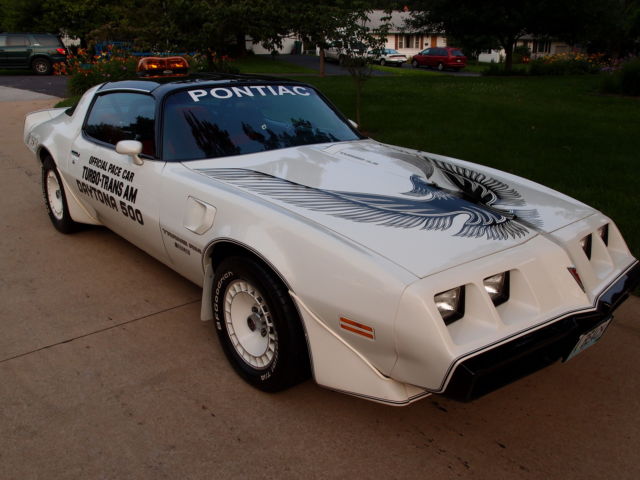

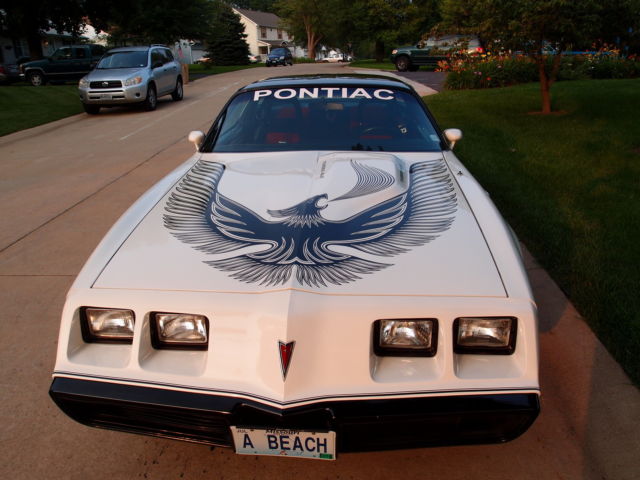

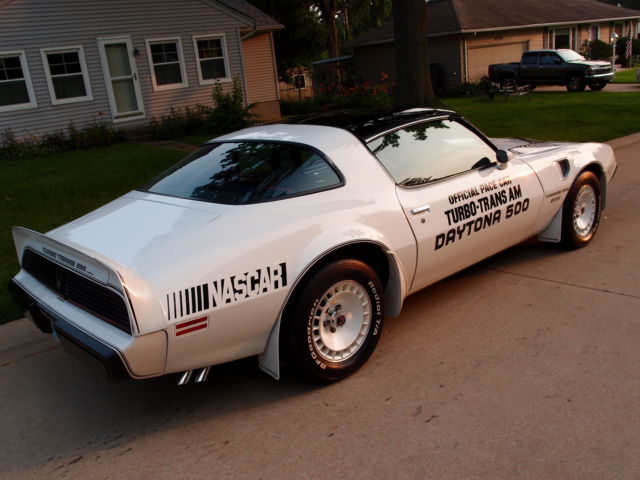
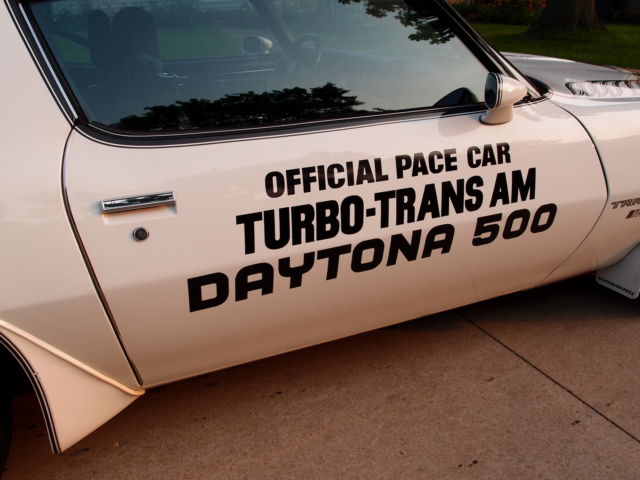
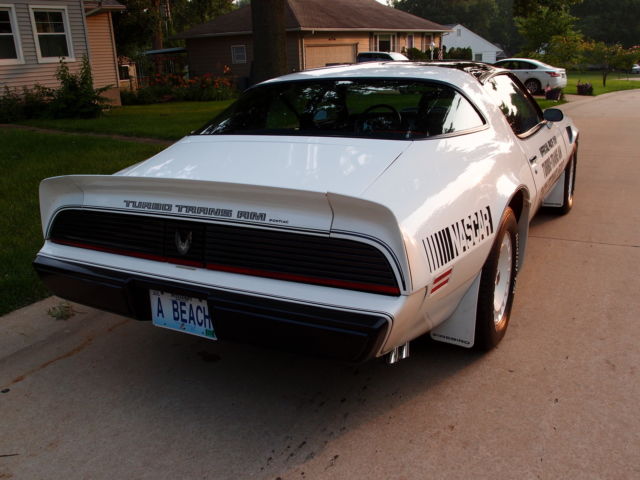
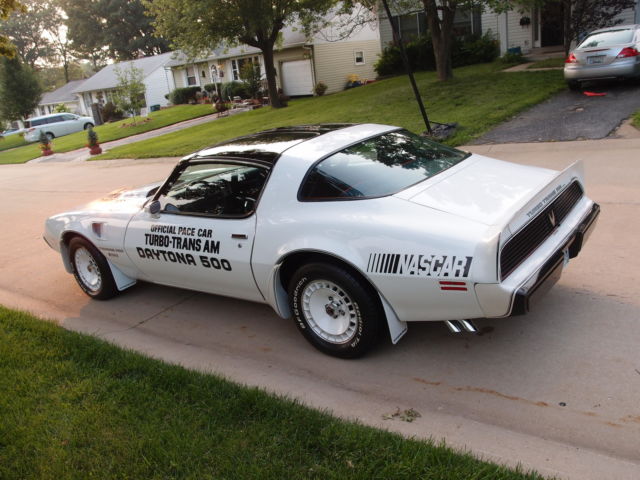




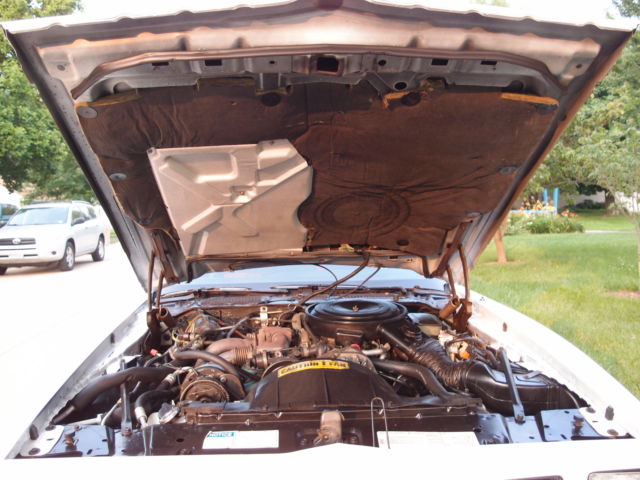
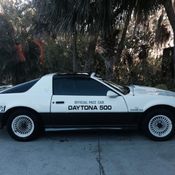 1983 TRANS AM DAYTONA PACE CAR 25TH ANNIVERSARY NASCAR VERY RARE
1983 TRANS AM DAYTONA PACE CAR 25TH ANNIVERSARY NASCAR VERY RARE
 1979 Pontiac Firebird Trans Am 10th Anniversary NASCAR Daytona 500 Pace Car
1979 Pontiac Firebird Trans Am 10th Anniversary NASCAR Daytona 500 Pace Car
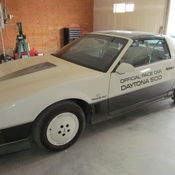 1983 PONTIAC TRANS AM PACE CAR DAYTONA 500 NASCAR LIMITED EDITION RECARO
1983 PONTIAC TRANS AM PACE CAR DAYTONA 500 NASCAR LIMITED EDITION RECARO
 1981 Trans Am Turbo Nascar Pace Car
1981 Trans Am Turbo Nascar Pace Car
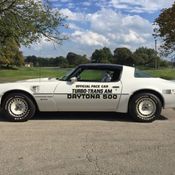 1981 Pontiac Trans Am Daytona Pace Car Original with 11766 miles " Survivor"
1981 Pontiac Trans Am Daytona Pace Car Original with 11766 miles " Survivor"
 1981 Pontiac Trans Am Turbo Daytona Pace Car Recaro Edition-NO RESERVE!!
1981 Pontiac Trans Am Turbo Daytona Pace Car Recaro Edition-NO RESERVE!!